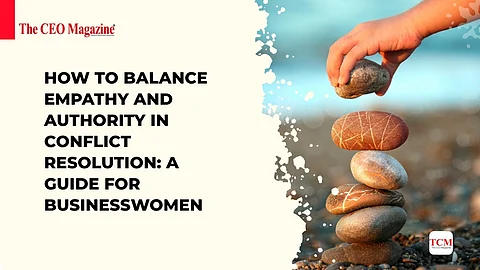
- News
- Women
- Magazine
- IndustryIndustry
- InsightsInsights
- Success Stories
- PublishPublish
- ContactContact
- Media KitMedia Kit

How to Balance Empathy and Authority in Conflict Resolution: A Guide for Businesswomen
In today's fast-paced business environment, effective conflict resolution is a vital skill for leaders, especially for businesswomen navigating complex interpersonal dynamics. Balancing empathy and authority can significantly enhance your ability to resolve conflicts constructively. Here’s how to approach this delicate balance.
Empathy is the ability to understand and share the feelings of others. It allows leaders to connect with their teams on a human level, fostering trust and collaboration. Empathy involves active listening, acknowledging emotions, and validating others' perspectives.
Authority, on the other hand, pertains to the power and respect you command in your role. It is essential for making decisions, enforcing policies, and guiding teams toward common goals. Balancing authority with empathy means using your power judiciously while remaining approachable and understanding.
Finding the right equilibrium between empathy and authority can lead to more effective conflict resolution in the following ways:
Improved Communication: When you empathize with your team, they feel heard and understood, which encourages open dialogue. This open communication can uncover the root causes of conflicts and facilitate collaborative solutions.
Enhanced Trust: Demonstrating empathy while maintaining authority builds trust within your team. Employees are more likely to approach you with concerns or conflicts if they feel that you value their perspectives.
Motivated Teams: When employees see that their leader balances empathy with authority, they are more motivated to contribute positively to the team and work towards resolutions rather than allowing conflicts to escalate.
Better Decision-Making: Empathy can inform your decisions, allowing you to consider the human element of business. This holistic approach can lead to solutions that satisfy both the needs of the business and the emotions of your team.
Active listening is crucial in conflict resolution. Make a conscious effort to listen without interrupting, and reflect back what you’ve heard to ensure understanding. This shows your team that you value their input and are willing to consider their viewpoints.
Encourage dialogue by asking open-ended questions that invite deeper discussion. This approach can help uncover underlying issues and demonstrate your commitment to understanding the perspectives of all parties involved.
Recognizing and validating the emotions of those involved in the conflict is essential. Phrases like “I understand that this is frustrating for you” can help diffuse tension and make team members feel respected.
While empathy is vital, maintaining authority requires setting clear boundaries. Establishing expectations for behavior during conflicts ensures that discussions remain constructive and focused on resolution rather than personal grievances.
Sometimes, authority must take precedence. If a situation escalates or becomes unproductive, be prepared to make decisions that are in the best interest of the team or organization. Clearly communicate your rationale, showing that your decision is informed by both empathy and authority.
Being vulnerable as a leader can help humanize your authority. Share your experiences with conflict and resolution, demonstrating that you, too, face challenges. This can foster a more open environment where team members feel safe expressing their concerns.
When resolving conflicts, offer feedback that is both constructive and compassionate. Highlight the positive aspects of the individual's behavior while also addressing areas for improvement. This approach reinforces your authority while maintaining an empathetic tone.
Invite team members to participate in the resolution process. This collaboration fosters a sense of ownership over the outcome and shows that you value their contributions, reinforcing both empathy and authority.
Balancing empathy and authority in conflict resolution is not merely a leadership skill but an art form that can significantly impact the dynamics of a team. By practicing active listening, acknowledging emotions, and setting clear boundaries, businesswomen can effectively navigate conflicts while maintaining a strong leadership presence. This balanced approach not only resolves issues but also fosters a healthy work environment conducive to collaboration, innovation, and success.
Follow us on Google News
